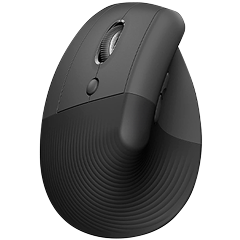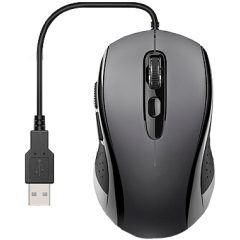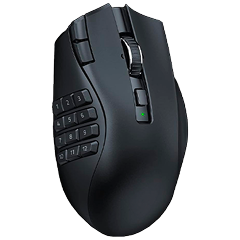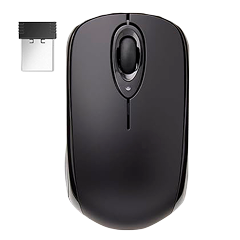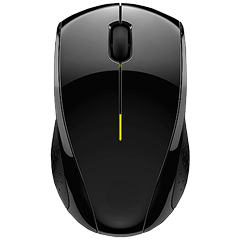Entre el trabajo y el tiempo libre, la mayoría de nosotros pasamos demasiado tiempo con la mano pegada al ratón. Tanto si estás examinando hojas de cálculo, echando una partida, luchando con una montaña de correos electrónicos o haciendo malabarismos con demasiadas pestañas del navegador, el ratón siempre está ahí y siempre se usa. Aunque los ratones para gaming suelen acaparar toda la atención, hay otro tipo de héroe, más aburrido, en el mundo de los periféricos: el mouse ergonómico, y para muchos usuarios es uno de los que no deberían pasar desapercibidos.
Mientras que los ratones para gaming dan prioridad al rendimiento puro y duro, los ergonómicos se centran en la comodidad, el apoyo y el uso a largo plazo. Están diseñados teniendo en cuenta el cuerpo humano y su objetivo es reducir la tensión en la muñeca, el antebrazo y el hombro. Puede sonar un poco dramático, pero con el tiempo, una mala ergonomía en el ratón puede provocar lesiones reales como RSI o síndrome del túnel carpiano, además de fatiga y malestar general.
Así pues, tanto si ya tienes molestias como si simplemente quieres cuidarte de cara al futuro, invertir en un buen mouse ergonómico es una de las mejoras más inteligentes que puedes hacer en tu escritorio.
En esta guía vamos a desglosar qué hace que un ratón sea ergonómico de verdad, exploraremos los distintos tipos disponibles y destacaremos lo que hay que tener en cuenta a la hora de elegir uno. También hablaremos de las opciones parcialmente ergonómicas, es decir, ratones que no lo ofrecen todo, pero que mejoran significativamente la comodidad diaria.
¿Qué hace que un ratón sea ergonómico?
A diferencia de los ratones de oficina estándar, los ratones ergonómicos están diseñados para trabajar con la posición natural de la mano, no contra ella. Reducen los ángulos incómodos de la muñeca, limitan la tensión en los tendones y fomentan una mejor postura. A menudo verás que estos ratones tienen formas poco convencionales, como cuerpos inclinados o incluso orientaciones totalmente verticales, y todo ello en aras de la biomecánica.
Un auténtico mouse ergonómico mantiene tu mano en una posición neutral, más cercana a la que tu cuerpo preferiría mantener de forma natural. Sería como un apretón de manos y no con la palma mirando hacia abajo. Esta orientación reduce la torsión de tu antebrazo y favorece un agarre más relajado. Para algunos usuarios, este tipo de cambio sutil puede suponer una gran diferencia en cómo se sienten tras horas de uso y, lo que es más importante, en cómo aguanta su cuerpo a largo plazo.
Pero no se trata solo de los ángulos: un buen mouse ergonómico también puede tener en cuenta otros factores físicos como el tamaño, el tipo de agarre y la distribución del peso, así como aspectos más mecánicos como la disposición de los botones. Hay mucho que tener en cuenta y lo que funciona para una persona no será del todo adecuado para otra, por lo que es importante explorar toda la variedad de opciones.
Tipos de ratones ergonómicos
Aunque todos comparten el mismo objetivo, hay algunos estilos distintos de mouse ergonómico que actúan de maneras diferentes. Veamos los tipos más comunes y lo que los diferencia.
Ratones verticales
Probablemente son los primeros que te vienen a la cabeza cuando piensas en un mouse ergonómico. Los ratones verticales posicionan la mano en un ángulo de entre 70 y 90 grados, casi como la mano de una minifigura de LEGO. Esto reduce la rotación del antebrazo y la muñeca, lo que puede aliviar la presión y favorecer una postura más natural. Al principio hay que acostumbrarse a ellos, y puede que algunas personas nunca lleguen a adaptarse del todo, pero si consigues hacerlo, pueden cambiar las reglas del juego.
Ratones contorneados y angulados
Algunos ratones ergonómicos se sitúan en un término medio, siguiendo el mismo concepto que los ratones verticales pero sin llegar a tal extremo. Estos ratones suelen estar levemente ladeados, con una inclinación más natural en comparación con un ratón completamente plano, pero ponen más énfasis en la forma general del cuerpo y en cómo se adapta a tu mano.
A menudo verás que este tipo de ratones tienen una forma más pronunciada que se adapta a tu mano, junto con un reposapulgares para mantener una mejor postura. Estas opciones parcialmente ergonómicas siguen teniendo como objetivo reducir la tensión de la muñeca y el brazo, pero son más fáciles de sujetar y usar de inmediato, y se parecen mucho más a un ratón convencional.
Trackballs
Los ratones con trackball dan la vuelta al concepto tradicional de los ratones en busca de una mayor ergonomía y control. En este caso, en lugar de mover todo el ratón, haces girar una bola con el pulgar o los dedos para mover el cursor. Esto reduce significativamente el movimiento del brazo y el hombro, ya que la mayor parte del trabajo se hace con los dedos. Esta opción es ideal para usuarios con movilidad reducida, puede ayudar a reducir el riesgo de lesiones por esfuerzo repetitivo, y además requiere menos espacio en el escritorio, lo cual es una ventaja adicional.
Sin embargo, aprender a utilizar un ratón trackball requiere bastante práctica, mucho más que cualquiera de las otras dos opciones ergonómicas. Sin embargo, la recompensa puede ser muy grande, ya que, para el flujo de trabajo adecuado, los ratones con trackball pueden ser muy eficientes y ofrecen mejor control que cualquier otro tipo.
Si eres un editor de vídeo que trabaja con líneas de tiempo, un diseñador que trabaja con software CAD o de modelado, o incluso que trabaja con hojas de cálculo gigantes, un mouse trackball ergonómico no solo te hará el día más cómodo, sino también más eficiente.
Características clave que debes tener en cuenta
Forma y ángulo
El rasgo más notable de un mouse ergonómico siempre será la forma, que marca la pauta e influye en todas las demás características. Necesitarás un ratón que se adapte a la posición y características naturales de tu mano, probablemente uno con una inclinación suave o una orientación totalmente vertical. Debe guiar tu muñeca hacia una posición neutra en lugar de forzarla a estar plana.
Tamaño y ajuste
De nada sirve tener un mouse ergonómico si no se adapta a tu mano: si es demasiado pequeño, lo agarrarás forzando demasiado la mano y perdiendo así sus ventajas; si es demasiado grande, tus dedos se estirarán de forma incómoda al intentar alcanzar los botones o lo sujetarás fuera de las curvas ergonómicas. Te recomendamos que compares las dimensiones de las páginas de producto con las de tu ratón actual (o incluso con un objeto ficticio) o, mejor aún, que pruebes algunos en persona en una tienda.
Colocación de los botones
Solo porque un mouse sea ergonómico no significa que tengas que renunciar a características adicionales y, de hecho, elementos como los botones adicionales también pueden mejorar la ergonomía. Extender demasiado la mano para llegar a los botones puede anular el propósito del diseño ergonómico, y un ratón bien diseñado tiene los botones primarios y secundarios al alcance de la mano, con una disposición lógica para los extras, como los modos de retroceso/avance o rueda de desplazamiento. Piensa en tus acciones más habituales y si te vendrían bien este tipo de botones, y luego imagina cómo preferirías pulsarlos.
DPI y sensibilidad ajustables
Esto va más allá de las características ergonómicas en sí, y entra mucho más en las comparaciones generales de ratones. Solo porque sea bueno para tu cuerpo no significa que no pueda serlo también para tu PC. Busca características como un ajuste de DPI que te ayude a adaptar tu experiencia.
Un DPI más bajo hará que el ratón sea más fácil de controlar con movimientos suaves, por ejemplo. Sin embargo, no esperes que en todas las páginas de producto aparezcan las especificaciones completas del sensor, ya que no es un aspecto tan importante como en los ratones para gaming, y algunas marcas optan por ocultar estos detalles o incluso no compartirlos. No se trata de una señal de alerta como tal, aunque es de esperar que las grandes marcas ofrezcan esta información.
¿Merecen la pena los ratones parcialmente ergonómicos?
La respuesta corta es que sí, sin duda alguna. Una pequeña mejora es mejor que ninguna, y eso es lo que pasa con todos los tipos de ergonomía, de ratón o de cualquier otro tipo. Para los usuarios que hayan notado un poco de fatiga ocasional en las manos o los que estén iniciándose en las mejoras ergonómicas, estos híbridos son un buen punto de partida. Obtendrás la mayoría de las ventajas de la comodidad sin el periodo de adaptación.
No todo el mundo necesita (o quiere) un cambio radical en su equipo como el que tendrías con un ratón vertical. Puede que algunas personas nunca consigan acostumbrarse a un ratón trackball, y no pasa nada. A veces, pequeñas mejoras en la forma, el tamaño o la colocación de los botones pueden mejorar significativamente la comodidad diaria y compensar a largo plazo.
Puede que no griten «ergonómico» a primera vista, pero están diseñados pensando en su uso a largo plazo en la oficina. Busca un ratón con un cuerpo levemente inclinado y perfilado que apoye la mano de forma más natural que los modelos planos, que a menudo incluyen pequeños detalles como reposapulgares y ruedas de desplazamiento de giro libre.
Flujo de trabajo, no solo dolor de muñeca
Es fácil asociar los ratones ergonómicos únicamente con la prevención de lesiones y el apoyo físico, y por supuesto eso es una gran parte de su valor, pero también pueden ofrecer ventajas en el flujo de trabajo. Es más probable que controles con precisión y confianza un ratón que te resulte más cómodo de usar. Eso puede traducirse en menos errores, movimientos más rápidos y un mayor disfrute del tiempo que pasas en tu escritorio.
Muchos modelos ergonómicos también incluyen software que te permite asignar funciones personalizadas a los botones, cambiar los modos de DPI sobre la marcha o incluso gestionar varios dispositivos a la vez. Son ventajas que a menudo asociarías a los ratones para gaming, pero también aportan muchas ventajas de productividad y van de la mano de un diseño ergonómico, por lo que son estupendos para las personas que hacen varias cosas a la vez.
La comodidad es una prioridad
Si pasas muchas horas al día usando el ordenador, un mouse ergonómico no es solo un accesorio que conviene tener: es una inversión a largo plazo en tu comodidad y tu salud. Tanto si te dedicas a cumplir plazos, a limpiar bandejas de entrada o a gestionar hojas de cálculo complejas, el ratón adecuado puede ayudar a que tu mano permanezca cómoda y, en consecuencia, a que tu concentración sea óptima.
La ergonomía es un poco como un espectro, tanto en lo que se refiere a lo lejos que lleves sus características individuales como a la forma de ajustarlas a tus necesidades concretas. Esto significa que no tienes que lanzarte directamente a la piscina con un trackball o un ratón totalmente vertical; simplemente alejarte del diseño básico y plano de los ratones tradicionales puede dar grandes frutos.
Empieza por escuchar a tu cuerpo y tener en cuenta la disposición de tu equipo, cómo usas tu ratón actual y qué problemas te está causando (si los hay), y luego avanza por ese espectro ergonómico hasta que encuentres el punto óptimo. Recuerda que, en última instancia, la ergonomía no consiste en perseguir la perfección, sino en realizar cambios y mejoras significativos que funcionen para ti, clic a clic.


